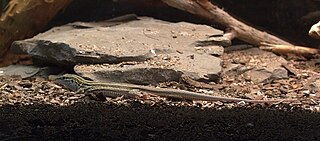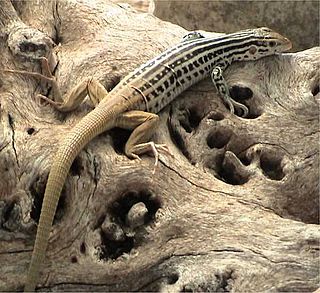
Aspidoscelis is a genus of whiptail lizards in the family Teiidae.

The western whiptail is a species of lizard in the family Teiidae. The species ranges throughout most of the southwestern United States and northern Mexico. Most of its populations appear stable, and it is not listed as endangered in any of the states comprising its range. It lives in a wide variety of habitats, including deserts and semiarid shrubland, usually in areas with sparse vegetation; it also may be found in woodland, open dry forest, and riparian growth. It lives in burrows. Major differences between this species and the checkered whiptail include the lack of enlarged scales anterior to the gular fold and the presence of enlarged postantebrachial scales. It was previously known as Cnemidophorus tigris, until phylogenetic analyses concluded that the genus Cnemidophorus was polyphyletic. Since it does not migrate, a number of forms have developed in different regions, several of which have been given subspecific names – for example the California whiptail, Aspidoscelis tigris munda.

The desert grassland whiptail lizard is an all-female species of reptiles in North America. It was formerly placed in the genus Cnemidophorus. A common predator of the whiptail lizard is the leopard lizard, that prey on A. uniparens by using ambush and stalk haunting tactics. These reptiles reproduce by parthenogenesis. In this process, eggs undergo a chromosome doubling after meiosis, developing into lizards without being fertilized. However, ovulation is enhanced by female-female courtship and "mating" (pseudo-copulation) rituals that resemble the behavior of closely related species that reproduce sexually.

The orange-throated whiptail is a species of lizard in the family Teiidae. The species was previously placed in the genus Cnemidophorus. Three subspecies are recognized as being valid, including the nominotypical subspecies.

The Texas spotted whiptail is a species of long-tailed lizard, in the family Teiidae. The species is endemic to the south central and southwestern United States and northern Mexico. Six subspecies are recognized as being valid.

The gray checkered whiptail is a species of lizard in the family Teiidae. The species is native to the United States in southern New Mexico and western Texas, and northern Mexico.

The Chihuahuan spotted whiptail is a species of lizard native to the United States in southern Arizona, southern New Mexico and southwestern Texas, and northern Mexico in northern Chihuahua and northern Sonora.
The Laredo striped whiptail is a species of lizard found in the southern United States, in Texas, and northern Mexico in Coahuila and Tamaulipas. Some sources believe it to be the result of extensive hybridization between the Texas spotted whiptail, Aspidoscelis gularis and the six-lined racerunner, Aspidoscelis sexlineatus. It is one of many lizard species known to be parthenogenic.
The marbled whiptail is a species of lizard found in the United States, in southern New Mexico and Texas, and in northern Mexico, in Coahuila, Chihuahua and Durango.

The New Mexico whiptail is a female-only species of lizard found in the southwestern United States in New Mexico and Arizona, and in northern Mexico in Chihuahua. It is the official state reptile of New Mexico. It is one of many lizard species known to be parthenogenetic. Individuals of the species can be created either through the hybridization of the little striped whiptail and the western whiptail, or through the parthenogenetic reproduction of an adult New Mexico whiptail.
The plateau spotted whiptail is a species of lizard found in the southern United States in Texas, and in northern Mexico in Chihuahua and Coahuila. It is known to hybridize with the Eastern Spotted Whiptail, Cnemidophorus gularis, but is considered to be a distinct species due to phenotypic characteristics.

The checkered whiptail is a species of lizard found in the southwestern United States in Colorado, Texas and New Mexico, and in northern Mexico in Chihuahua and Coahuila. Many sources believe that the species originated from the hybridization of the marbled whiptail, Aspidoscelis marmoratus, the plateau spotted whiptail, Aspidoscelis septemvittatus, and possibly the six-lined racerunner, Aspidoscelis sexlineatus. It is one of many lizard species known to be parthenogenic. It is sometimes referred to as the common checkered whiptail to differentiate it from several other species known as checkered whiptails.

The six-lined racerunner is a species of lizard native to the United States and Mexico.

The little striped whiptail is a species of lizard found in the southwestern United States and in northern Mexico. A significant amount of research was done on the species during the mid-1990s, with several new subspecies being added, many of which some sources consider to be distinct enough to warrant full species status, and the research is ongoing. It is called little to distinguish it from many other species known as striped whiptails and to indicate that it is the smallest of those species.

Cnemidophorus sexlineatus viridis, commonly known as the prairie racerunner, is a subspecies of lizard endemic to the United States. It is a subspecies of Cnemidophorus sexlineatus, which is commonly known as the six-lined racerunner lizard.

Dactylotum bicolor, also known as the rainbow grasshopper, painted grasshopper, or the barber pole grasshopper, is a species of grasshopper in the family Acrididae. It is native to the United States, Canada and northern Mexico and exhibits aposematism. It was first described by the German entomologist Toussaint de Charpentier in 1843.
The Arizona striped whiptail is a species of whiptail lizard endemic to the United States. This is a species of lizards that lives in Arizona's grassy desert areas and is normally found hiding in desert shrubs. They are approximately 72 millimetres (2.8 in) long, and, like all whiptails, they have a noticeably long whiplike tail hence the name whiptail and they are fast runners.












